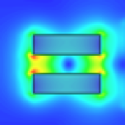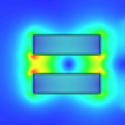Slowing light with plasmonic molecules
Under the right conditions, atomic gases can exhibit an unusual optical phenomenon called electromagnetically induced transparency (EIT). Applying a field to a three-level atom can cause destructive interference between energy levels that might otherwise absorb light, rendering the atom effectively transparent. Writing in Physical Review Letters a group at the University of California in Berkeley suggest a way in which these optical effects can be produced in metamaterials.
Shuang Zhang, Dentcho Genov, Yuan Wang, Ming Liu, and Xiang Zhang propose a “plasmonic molecule” consisting of metal strips on an insulating substrate. One “atom” in the molecule is a single conducting strip designed to couple efficiently to an applied electromagnetic field. Next to this is a “dark” atom made from two smaller strips with a carefully selected separation so that the strips only weakly couple to the field. Placing these two structures side by side causes destructive interference between the radiative state and the dark state, similar to EIT in an atomic system. The result, which the group confirms with simulations, is a small spectral window of transparency in the broad absorption band.
Zhang et al. also find a highly dispersive response at the dip, indicating a significantly lower group velocity similar to that seen in slow-light experiments with atomic gases. Taking their proposal further, they designed a metamaterial consisting of periodic arrays of plasmonic molecules. Such a material could exhibit transparency and slow-light effects at room temperature over a broad bandwidth, and be easily incorporated into other plasmonic circuits. –- David Voss





